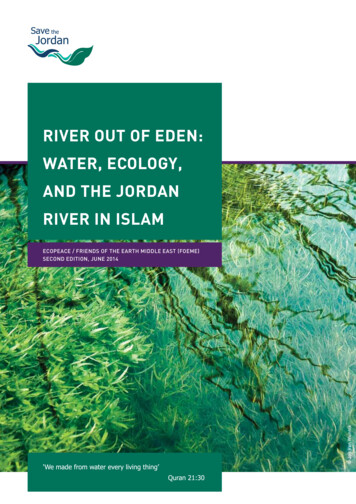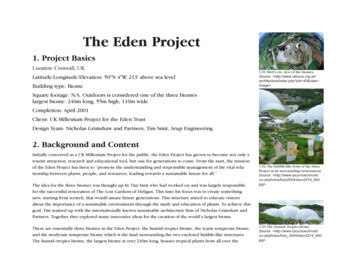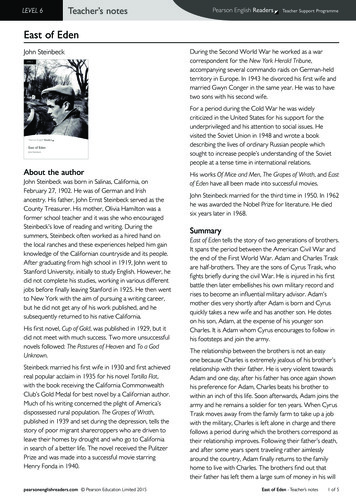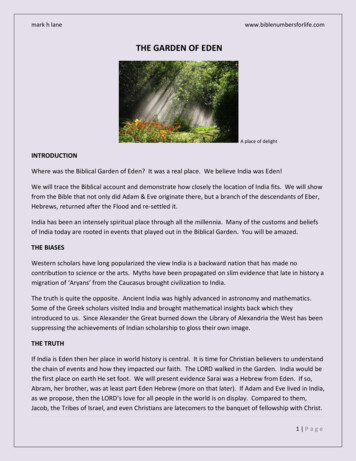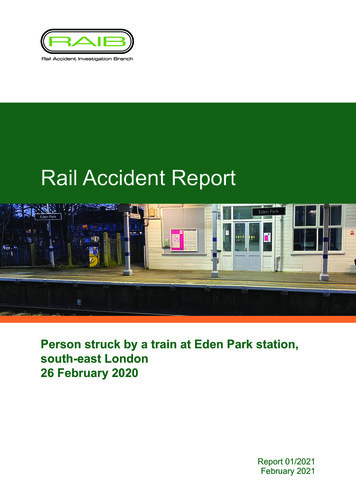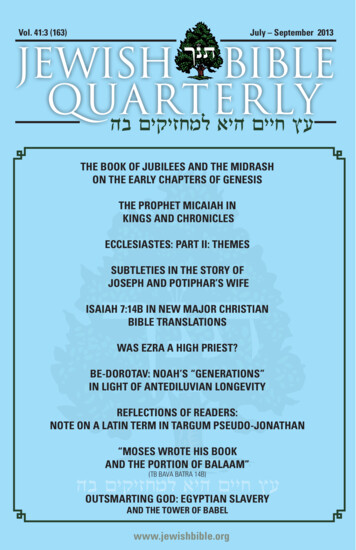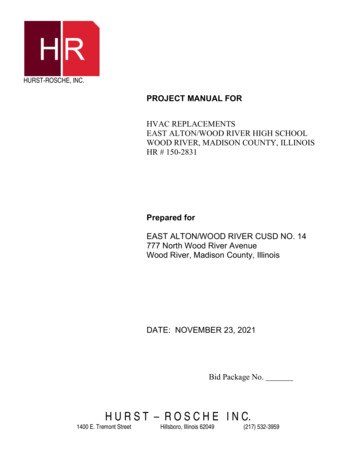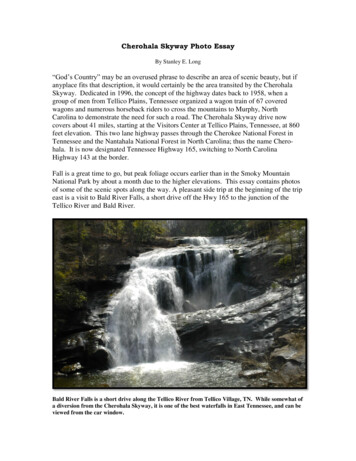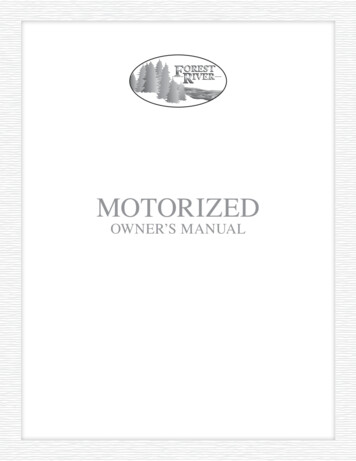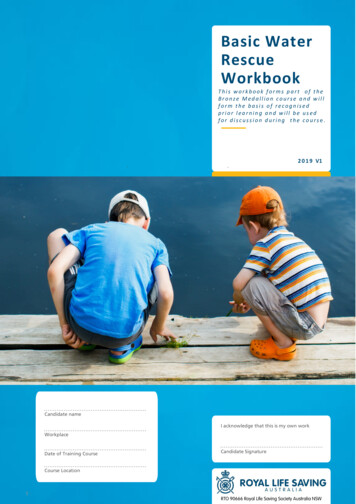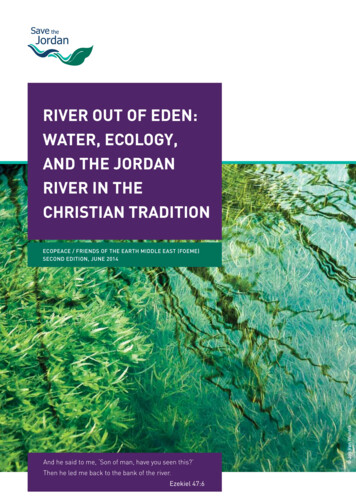
Transcription
RIVER OUT OF EDEN:WATER, ECOLOGY,AND THE JORDANRIVER IN THECHRISTIAN TRADITION Jos Van WunnikECoPEACE / FRIENDS OF THE EARTH MIDDLE EAST (FoEME)second EDITION, June 2014
COVENANT FOR THEJORDAN RIVERWe recognize that the Jordan River Valley is alandscape of outstanding ecological and culturalimportance. It connects the eco-systems ofAfrica and Asia, forms a sanctuary for wildplants and animals, and has witnessed some ofthe most significant advances in human history.The first people ever to leave Africa walkedthrough this valley and drank from its springs.Farming developed on these plains, and inJericho we see the origins of urban civilizationitself. Not least, the river runs through the heartof our spiritual traditions: some of the foundingstories of Judaism, Christianity, and Islam areset along its banks and the valley contains sitessacred to half of humanity. By any measure,this landscape must be counted as part of theheritage of humankind.But over the past 50 years, the Lower JordanRiver has been destroyed. 96% of its historicflow has been diverted. What little waterremains is polluted with saline and effluent,including untreated sewage. The valley’swetlands have dried up, its springs are failing,and half its biodiversity has been lost. This isnot just a tragedy for wildlife: families haveseen their fields turn to dust, not from a lack ofwater but from the injustice of its distribution.The demise of the Jordan and the collapse of thevalley’s eco-system represents a failure of ourmost basic responsibility towards the specieswhose habitats have been destroyed and theecological systems that sustain life on earth.It is a neglect that leaves us impoverished,that cripples the growth of an economybased on tourism, and that exacerbates thepolitical conflicts that divide this region. Italso exemplifies a wider failure to serve ascustodians of the planet: if we cannot protect aplace of such exceptional value, what part of theearth will we hand on intact to our children?We have a different vision of this valley: a visionin which a clean, living river flows from the Seaof Galilee to the Dead Sea; in which the valley’splants and animals are afforded the water theyneed to flourish; in which the springs flow asthey have for millennia; and in which the waterextracted for human use is divided equitablybetween the nations that share the valley andthe people who live here.Realizing this vision will not be easy. Butdifficulty cannot be an excuse for inaction. Wetherefore call upon the governments of thecountries that share this watershed to make aserious commitment of resources and politicalcapital to the rehabilitation of the Jordan River.As individuals and organizations, as membersof civil society, and as religious or communityleaders, we also affirm that this is a landscapeof universal ecological, cultural, and spiritualimportance, and commit to work towards thevision expressed in this covenant.
Dear Friends,This is a toolkit of information to help Christian communities around the world learn about thecondition of the Jordan River and join in efforts to rehabilitate the once mighty Jordan.The first section describes the demise of the Jordan River, what went wrong, and why it matters.The second section provides a compilation of writings about the place of the Jordan River in theChristian tradition, the sacredness of water, and the connection between spiritual faith and care forthe natural world. Two essays about the state of the river and the role of the Christian communityin its rehabilitation have been commissioned for the sourcebook. You will also find sacred texts,prayers, songs, poems, and essays. You are welcome to use these works as the basis for your ownpresentations or sermons or to adapt them to suit your audience.Section three includes sample lesson plans and questions to assist educators in designingprograms for a wide range of age groups. The final pages contain suggestions for how yourcommunity can support regional efforts to rehabilitate the Jordan River. We hope that you willurge decision makers to join in the revitalization of the Jordan. Additional resources to supportawareness campaigns and plan visits to the river are available at www.SavetheJordan.com.Please treat this as a working document: annotate it, select what is most illuminating, and enrich itthrough your own knowledge and insight. We hope that these materials inspire your congregationor class to join in the campaign to revive the Jordan River.Thank you for participating in the campaign to revive the Jordan River.With gratitude,EcoPeace / Friends of the Earth Middle EastJune 2014
Table Of ContentsCovenant for the Jordan RiverI. BACKGROUND311The Garden of the Lord13An Ecosystem Destroyed16The Destruction of the Jordan Some Facts and Figures17A Failure of Wisdom18A New Vision of the Valley20A Measure of Progress21Justice, Peace, Prosperity22Reviving the Jordan23II. SOURCES OF INSPIRATIONThe Blessing of Water: A Sermon on the Jordan River2526Father Gregory CollinsAbbot of the Dormition Abbey in Jerusalem729An Orthodox Christian Reflection On Creation CareRev. Dr. John Chryssavgis, Archdeacon of the Ecumenical ThroneThe Jordan River and the Natural World in the Old Testament32RIVER OUT OF EDENThe Sacredness Of Water
The Jordan River in the Gospels34Prayers, Poems, and Other Writings35Hymns & Songs38Times and Seasons42Other Reflections & Insights44Non-Ecclesiastical Writings Urging Care for CreationChristian Declarations and Essays on Ecology47The Christian Declaration on Nature Father Lanfranco SerriniTo Commit a Crime Against the Natural World Is a Sin50Ecumenical Patriarch Bartholomew I of ConstantinopleOther Christian Statements on Ecology53Troubling Waters: The Jordan River Between54Religious Imagination and Environmental DegradationIII. EDUCATIONAL RESOURCESSaving the Jordan, Saving Ourselves5556IV. IDEAS FOR COMMUNITY ACTION63V. CREDITS67
I. BackgroundThe Jordan River has suffered an ecological collapse. What wentwrong and why does it matter.
The Garden of the LordFor Christians, the Jordan is a symbol of purity. Christ’s baptism in the rivermarks His revelation as the Son of God and the beginning of His ministry onearth. This is a river that flows through the heart of our spiritual tradition.It’s not too late. EcoPeace / Friends of the Earth Middle East (FoEME) asks youto join us in calling for a return of water to this river, and a return of life to theJordan Valley.RIVER OUT OF EDENThis is a man-made disaster – one that shows an utter disregard for the natural world, for our Christian heritage, and for our responsibility as custodiansof God’s earth.13Today, the river has been all but destroyed. 96% of its flow has been diverted.What little water remains is polluted with saline and untreated sewage. Thevalley’s wetlands have dried up, its springs are failing, and half its biodiversityhas been lost.
“By any measure – ecological,cultural, spiritual - this river Jonathan Kalan / FoEMEmust be counted as part of theheritage of all humankind, andas a place of exceptionalimportance to Christians”A source of lifeAs soon as Jesus was baptized, he went upout of the water. At that moment heavenwas opened, and he saw the Spirit of Goddescending like a dove and alighting onhim. And a voice from heaven said, “Thisis my Son, whom I love; with him I am wellpleased” Matthew 3:16-17The river in which this baptism takes place is,in the Christian imagination, a mighty river – ariver that, according to the book of Joshua,“overfloweth all his banks all the time of harvest”(Joshua 3:15).Even more importantly, the river is clean.Baptism is primarily a ritual of cleansing andrenewal. This is what has made the Jordan’sA Blessed LandUntil about 50 years ago, the river looked muchas it did in the time of John and Jesus. From itssource in the foothills of Mount Hermon / JabelAl- Sheikh the Jordan rushed south into the Seaof Galilee, and then meandered more slowlyalong the length of the Jordan Valley until itdisappeared into the intensely saline lake of theDead Sea – the lowest point on the surface ofthe earth.All along the way, the Jordan River broughtlife to the valley. It created wetland habitatsin which wild plants and animals flourished.It greened a corridor through the desert,connecting the eco-systems of Eastern Africaand Western Asia and forming a flyway used bysome 500 million migratory birds each year. Andit allowed the flourishing of human life and theemergence of urban civilization.Some of the first people ever to leave Africawalked across this plain and drank from itssprings. And it was here, too, that the firstfarmers began to plant and harvest grain in thealluvial mud north of the Dead Sea. Agriculturewas the breakthrough that allowed villages todevelop into the world’s first towns, Jerichoamong them. Jericho’s walls were built some10,000 years ago, and it can claim to be theoldest continuously inhabited city anywhere inthe world.threshold that separates this world from theparadise beyond. When Joshua leads his peopleacross the river, its waters dry up to allowthem to pass over into freedom. It is here onthe banks of the Jordan that the Prophet Eliasascends to heaven in a whirlwind, and that themantle of prophethood passes to his successor,Elisha. And here, too, in a story that has longbeen seen as a pre-figuration of the Baptism,Naaman the Leper is healed by bathing in thewaters of the Jordan.River of MiraclesThe Jordan was part of the landscape thatJesus knew, and all of these stories wouldhave been familiar to Him. The Gospel traditiondraws on this image of the Jordan as a meetingplace between heaven and earth. Through thestory of Christ’s baptism, it is an image that hascarried over into the painting, poetry, and songof half the world.The river also runs through the heart of theChristian spiritual tradition.The earliest mention of the Jordan Valleycomes in the book of Genesis, where the plainis described as “well watered everywhere evenas the garden of the Lord ” (Genesis 13:10).Later, in the book of Joshua, an image of theriver as a place of transcendence begins toemerge. The Jordan becomes a kind of divine15For Christians, the name calls up an imagethat has been painted a thousand times: Jesusstanding in the water, his head bowed in prayer,while John pours the water of baptism overHim. As Matthew tells us –water into the very symbol of purity.In our myth and memory, then, this is a river ofmiracles. A river of life.By any measure, then – ecological, cultural,spiritual - this river must be counted as part ofthe heritage of all humankind, and as a place ofexceptional importance to Christians.RIVER OUT OF EDENImagine the River Jordan.
As the river has dried up, the Jordan Valleyhas suffered an ecological collapse. Half thevalley’s biodiversity has been lost. The DeadSea, sustained only by inflowing water from theJordan, is sinking by more than a meter everyyear.This is not just a tragedy for wildlife. Springsthat irrigated farmland for thousands of yearshave started to falter and fail. Wells used forgenerations have run dry. Refused access toThe neglect of this river shows a disregardfor our own spiritual heritage, as well as afailure to meet our moral responsibilities ascustodians of God’s earth. It also exacts a heavyprice from the nations that share the valley,crippling the growth of an economy that couldbe supported by tourism and exacerbating thepolitical conflicts that divide the region. This isan ecological collapse whose severity and cost –economic, ecological, human – we are only nowbeginning to count.“The neglect of this river cripples the growthof an economy that could be supportedby tourism and exacerbates the political The Lower Jordan River begins at the Seaof Galilee (also known as Lake Tiberius orLake Kinneret) and flows south for about120km before reaching its end at the DeadSea. The Lower Jordan Valley is divided betweenJordanians, Israelis, and Palestinians.Palestinians have no access to the Jordanand do not receive water directly from theriver. Until about 1950, some 1.3 billion cubicmeters of water flowed through the valleyevery year.Israeli, Jordanian, and Palestiniancommunities. The diversion and pollution of thiswater has caused an ecologicalcollapse - more than 50% of the valley’sbiodiversity has been lost. The dying of the Jordan is also causingthe Dead Sea to disappear – it is nowsinking at the rate of approximately onemeter per year. FoEME estimates that Israel diverts abouthalf of the river’s average annual flow,while Syria and Jordan take the rest. 96% of that flow has been diverted. Untreated or poorly treated sewagehas been dumped or allowed to leakinto the river for over 50 years from17In just over 50 years, the countries that sharethis watershed have dammed and diverted morethan 96% of the river’s historic flow. What littlewater remains is polluted with saline, sewage,and agricultural run-off. In places - including thesite at which John baptized Jesus - the river isnot much more than a stagnant canal of effluent.the river and denied a fair share of the waterpumped from beneath the land, Palestiniancommunities have seen fields turn to dust,livelihoods lost, and families forced to migrate.THE DESTRUCTION OFTHE JORDANSOME FACTS AND FIGURESRIVER OUT OF EDENNeither the natural beauty nor the spiritualsignificance of the Jordan has been enough tosave the river from being degraded. Daniel Adamson / FoEME Jonathan Kalan / FoEMEAn ecosystem destroyedconflicts that divide the region”
Jonathan Kalan / FoEME“ man’s dominion cannot beunderstood as license to abuse,spoil, squander or destroy whatGod has made to manifest hisglory. That dominion cannot beanything other than a stewardshipin symbiosis with all creatures At the risk of destroying himself,man may not reduce to chaos ordisorder, or, worse still, destroyGod’s bountiful treasures.”Father Lanfranco SerriniA failure of wisdomGiven the intensity of conflict in the region, thiszero-sum struggle for the valley’s water mightseem inevitable. But it is, in the long term, anapproach that will undermine the interests ofall concerned. This is a single watershed: theflow of its streams does not correspond to theborders drawn on our maps, and its rain andThis is surely not what was meant when Godgave man dominion over the earth. As FatherLanfranco Serrini, the leader of the Franciscanfriars at the time of the Assisi declarations onnature, has written “ man’s dominion cannot be understood aslicense to abuse, spoil, squander or destroywhat God has made to manifest his glory.That dominion cannot be anything otherthan a stewardship in symbiosis with allcreatures At the risk of destroying himself,man may not reduce to chaos or disorder,or, worse still, destroy God’s bountifultreasures.”On the contrary, our special place in God’s19At the root of the problem is conflict. The basinthat drains into the Jordan River is dividedbetween Lebanese, Syrians, Jordanians,Israelis, and Palestinians. Instead of seeing thevalley as a single, trans-boundary watershed,these nations have raced to capture the greatestpossible share of the Jordan’s water. FoEMEestimates that Israel diverts about half of theriver’s average annual flow, while Syria andJordan take about a quarter each. Palestinians,denied access to the river, take almost nothing.creation carries with it a responsibilityto cherish this earth. In the words of theEcumenical Patriarch Bartholomew I We are called to be stewards, andreflections of God’s love by example.Therefore, we proclaim the sanctity ofall life, the entire creation being God’sand reflecting His continuing will that lifeabound For humans to cause species tobecome extinct and to destroy the biologicaldiversity of God’s creation, for humans todegrade the integrity of Earth by causingchanges in its climate, by stripping theEarth of its natural forests or destroyingits wetlands, for humans to injure otherhumans with disease, for humans tocontaminate the Earth’s waters, its land, itsair, and its life with poisonous substances—these are sins.”The lack of a sense of wonder, the loss ofreverence for life, the abandonment of ourresponsibility as custodians – all this hascontributed to the demise of the Jordan. Therevival of the river, then, requires not just a shiftin policy, but a renewed spiritual effort to honorthe creation that God has entrusted to us.RIVER OUT OF EDENWhy has this happened? How have we allowedthis to happen to a place of such exceptionalbeauty and value?rivers cannot be sustainably managed through aprocess of competition.The demise of this valley also reveals a profoundlack of respect for the natural and non-humanworld. It exemplifies an attitude in which nature,including its water and all its forms of life,is seen as nothing more than a collection ofresources to be mined for human use.
Given the scarcity of water in parts of thisregion and the state of relations between thecountries that share the valley, realizing thisvision will not be easy. But difficulty cannot bean excuse for inaction. To do nothing is to leavea landscape irreparably damaged by our ownneglect.The starting point of any new approach must beto see this river and its tributaries as a single,interconnected ecosystem. If we want theJordan to survive – if we want to use this waterto sustain farms and families and economies –we have no choice but to manage it sustainablythrough cross-border cooperation.“If we want the Jordan to survive, we haveno choice but to manage it sustainablythrough cooperation.”In the last three years we have seen the firstsigns of progress in the effort to revive the river.Responding to years of advocacy, nationalgovernments and municipalities are nowworking to prevent the dumping or leaking ofuntreated sewage into the river. New treatmentplants are in development in Jordanian, Israeli,and Palestinian communities throughout theJordan Valley. FoEME is confident that half acentury of using the Jordan as a sewage canalcould soon come to an end.2013 also saw the first release of clean waterinto the Jordan River in 49 years. The IsraeliWater Authority has agreed to allocate 30mcm(million cubic meters) of fresh water every yearfrom the Sea of Galilee to help revive the river.This sets an important precedent for futureallocations, but it falls far short of FoEME’srecommendation that a third of the historic flowbe returned as part of an international effort torehabilitate the Jordan.FoEME is also developing the first crossborder master plan for the management ofthe Jordan River Valley – a plan that takesaccount of the valley’s fragile ecology as wellas recognizing the legitimate human need todraw on its water resources.The plan putsscientifically sound and economically realisticpolicy recommendations behind our visionfor the Jordan. Key recommendations includethe return of 400-600 mcm (million cubicmeters) of fresh water to the river; an end tothe dumping of raw or poorly-treated sewage,saline, and other effluents into the stream; andthe establishment of functioning internationalmechanisms for the joint management of thevalley’s water.With the support of national governments, thismaster plan can become the blueprint for therevival of the river.21This is a vision that reflects the image of thevalley that we see in the Gospels. A visionthat honors our heritage and that expressesreverence for God’s creation.A Measure of ProgressRIVER OUT OF EDENFoEME has a different vision for the JordanValley - a vision in which a clean, living riverruns from the Sea of Galilee to the Dead Sea;in which the valley’s plants, birds and animalsare afforded the water they need to flourish;in which the springs flow as they have formillennia; and in which water extracted forhuman use is divided equitably between thenations that share this valley and amongst thepeople who live here. Ofer Stein Daniel Adamson / FoEMEA New Vision of the Valley
“FoEME believes that a living Jordan Rivercan bring economic prosperity as well asecological health to this valley, and thatthe management of the valley’s waterprovides a practical opportunity for regionalcooperation and the advancement of justiceand peace.” FoEME recommends the release of 400600 million cubic meters (mcm) of freshwater into the river every year. In addition, the Jordan needs to flood atleast once each year in order to keep theriver’s ecosystem healthy (100m3/sec for24 hours). FoEME recommends that Israel release220mcm of water into the river eachyear, Syria 100mcm, and Jordan 90mcm.FoEME also recognizes that Palestine, asa riparian to the river, has a right to a fairshare of the Jordan’s water. FoEME’s analysis has identified over abillion cubic meters of water that couldbe saved by these countries (primarilythrough reduction of leaks, improvementsto irrigation efficiency, water harvestingand grey-water recycling, and demandmanagement) and used to revive the riverand to restore Palestinian water rights. The revival of the river requires thatJordanian, Israeli, and Palestiniandecision-makers implement nationalpolicy strategies to manage their owndemand for water, and to cooperate inthe implementation of a comprehensivetrans-boundary master plan for the river. This master plan should determine levelsof water flow, set water quality standards,identify ways to eliminate pollution,define ecological corridors, supportenvironmental rehabilitation programs,and advance plans for the development ofeco-tourism in the Jordan Valley. Implementation of a master plan requiresthe establishment of a functioning transboundary commission to manage thevalley’s water resources, resolve disputes,and strengthen the mechanisms ofcooperation.23In the past decade FoEME has opened eco-parks– ideal places to stay and learn - on both sidesof the Jordan. We are now working towards thecreation of a trans-boundary ecological peacepark centered on one of the river’s historiccrossing points, on the border between Israeland Jordan. The peace park will welcome visitorsfrom both sides of the valley, providing a muchneeded point of access to a river that, for muchof its length, remains a closed military zone.Reviving the JordanRIVER OUT OF EDENWe believe the Jordan can be revived withoutweakening the valley’s agricultural economy orcausing a shortage of water for human use. Inthe countries that share the valley, FoEME hasidentified over a billion cubic meters of waterthat could be saved (see the fact box page 18)and used to restore basic water rights to thePalestinians, to revive the Lower Jordan River,and to save the Dead Sea. Francesco Zizzola Francesco ZizzolaJustice, peace, prosperity
RIVER OUT OF EDEN25II. Sources of Inspiration
The blessing of water: a sermon on the Jordan RiverFather Gregory CollinsAbbot of the Dormition Abbey in JerusalemOn Jordan’s bank the Baptist’s cry announces that the Lord is nigh(Hymn for Advent)Suddenly Jesus appears. Although sinless, hevoluntarily joins the row of repentant sinnersand consents to receive the purifying watersadministered by the Baptist’s hand. It is aprofound gesture of divine solidarity with sinfuland suffering humankind. Suddenly there isa dramatic manifestation. The heavens areopened and the voice of God the Father isheard declaring that Jesus is his beloved Son.A further level of symbolism is added in thedescending dove, representing the Holy Spirit.This signifies Jesus’ anointing, the act by whichThe whole scene is a tremendous epiphany, ormore precisely a theophany - a manifestationof God, who, for Christians, is understood tobe the Most Holy Trinity: Father, Son and HolySpirit. In a hymn from the Byzantine liturgy, thethree are identified as such. The Son appears asa servant - the unique suffering servant of Godprophesied by Isaiah; the voice of the Father isheard, bearing witness to his only Son; the HolySpirit’s form recalls the dove which signaledthe end of the great flood, appearing at Noah’sark with the leaf of the olive tree in its beak. Butwater has always been a massively importantsymbol in the Judeo-Christian tradition, whetherit was the original waters over the face of whichGod’s Spirit hovered at the dawn of creation, orthe great river which Ezekiel in his vision sawissuing from the restored Temple in Jerusalemand flowing down towards the desert places ofthe Holy land, giving them new life and fertility.None of that is entirely unique to the JudeoChristian tradition. After all, water is, as theSwiss psychologist C. G Jung so often noted, abasic archetypal symbol for new life, fertility,rebirth and rejuvenation. It functions as such inevery religion and in every major belief system.It is small wonder then that the Jewish tradition(so associated in its geographical locationwith the preservation of water as a preciouscommodity) should frequently employ it as ametaphor for God’s saving presence, or thatthe ministry of Jesus – who promised to givehis followers a water that would quench everythirst – should have begun on the banks ofthe Jordan, the river that Joshua had crossedto bring the people of God into the promisedland. To this day, the waters of the Jordan areassociated with the sacrament of baptism.Many people still travel there to be baptized inthe same river as Jesus and some of its wateris still brought to England for the baptism ofroyal babies.Yet if one stands today on Jordan’s banks onedoes indeed hear a cry, but it is not that of theBaptist: rather, nature herself is crying! She isweeping hard and long. It is difficult not to feelthat one is witnessing a very different miraclefrom the great revelation at Jesus’ baptism. Themiracle is that the sad, depressing, depletedtrickle of water, oozing along where this mightyriver once flowed has not simply given up theghost and died long ago! For this great river,so rich in symbolic associations for Jews andChristians, is but a poor shadow of its self:it has become a standing testimony to whatwe grasping humans are capable of doing toGod’s beautiful creation, when our actionsare inspired largely by political and economicpragmatism - and uninspired by any largersense of cosmic vision.“This great river has become a standingtestimony to what we are capable of doingto God’s creation when our actions areuninspired by any larger sense of cosmicvision”In the liturgies of the eastern churches, thefeast of the baptism of Jesus on 6 Januaryincludes a great blessing of whatever watersare present in the vicinity of the celebration –rivers, lakes or streams. The texts used oftenecho ancient beliefs that water, the primalsource of life, has become the abode of demons.The blessing of the waters is therefore a kindof exorcism which expels the power of evil fromthem. Syrian liturgical texts also speak of thefire of Christ’s divinity going down into the waterto bless and purify it. It is a powerful prophecyof his future descent into the Underworld onHoly Saturday, where he goes to destroy deathby his death before rising in glory to the new lifeof the resurrection.But nowadays it is hard to avoid a powerfulfeeling: it is not the waters which needexorcism. Rather it is we ourselves! It is we, we27It is one of the great moments in the Christianunderstanding of salvation history. Jesus hadbeen living an ordinary life, indeed a hiddenlife, as a carpenter in the obscure village ofNazareth. Suddenly he appears at the banksof the Jordan. He comes into contact with thestrange, outlandish figure of John the Baptist,a wild man, a desert dweller, a prophet, whohas been preaching an austere message ofconversion, calling on people to change theirlives and accept baptism for the forgivenessof their sins because the kingdom of God isdrawing near.he is manifested not only as God’s unique andeternal Son-made-flesh but as the long-awaitedMessiah, Christos in Greek, the One who willbring in the kingdom of God. St. Luke in hisaccount adds a small but highly significantdetail, typical of his interest in the moreintimate, private aspects of Jesus’ relationshipwith his heavenly Father – he tell us that Jesusreceived the Holy Spirit while he was at prayer.RIVER OUT OF EDENEvery year since the earliest centuries of theChurch, Christians in both east and west havecelebrated the dramatic event, (recorded in thethree “Synoptic Gospels”, Matthew, Mark andLuke), with which the ministry of Jesus began:his baptism in the river Jordan.
The Sacredness of WaterAn Orthodox Christian Reflection on Creation CareRev. Dr. John Chryssavgis, Archdeacon of the Ecumenical Throne“Nature itself is God’s primal sacrament in its order and harmony, in its rhythmof light and darkness, and above all in itsoverwhelming beauty, it is meant to awakenus to the presence of the divine”But it is hard for today’s Jordan to do that, hardfor it to be a sacrament of cosmic beauty, hardfor it to remind us of the grace that flowed inthe mystery of Jesus’ baptism. For it to do thatagain, concerted action is needed – action bythe governments through whose territories itflows, action enabling it to become a source oflife-giving water once again. And we need to acton ourselves – to root out of our hearts all thoseimpulses of negligence and laziness, or worsestill of active exploitation, which damage nature,obscure God’s manifestation in and through hisMay the Creator God, the Source of all beings,who wishes to make his presence knownthrough the beauty of his works and who inChristian belief, saved and re-consecratedthe earth in Christ’s incarnation death andresurrection, purify us, so that we too can purifythe earth and liberate this once great river tobecome again what it is meant to be: a cosmicsacrament of God’s overflowing life and grace.Amen.The cleansing and conservation of the JordanRiver is a critical project from an ecological,but also from a religious – indeed, an interfaith– perspective. The rehabilitation of the lowerJordan River valley is an invaluable enterpriseto promote
comes in the book of Genesis, where the plain is described as “well watered everywhere even as the garden of the Lord ” (Genesis 13:10). Later, in the book of Joshua, an image of the river as a place of transcendence begins to emerge. The Jordan becomes a kind of divine “By a
